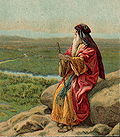The real Moses – Sh’mot
 Now that we have concluded the Book of B’reshit we have moved on from the patriarchs and meet up with Moses, who will be our companion to the very end of D’varim.
Now that we have concluded the Book of B’reshit we have moved on from the patriarchs and meet up with Moses, who will be our companion to the very end of D’varim.
Ahad HaAm asks the question, “What, essentially, was Moses?” Note the question – not “What was Moses?” but “What, essentially, was Moses?”
Without the word “essentially” we would presumably offer a bio, where and when Moses was born, what happened at various points of his career, where and how his life came to an end.
But that’s not what Ahad HaAm wants to know. He is looking for the essence of Moses, not the events of his life but the type of man he was, and why he matters to history.
He answers his own question by calling Moses a prophet; the rabbinic tradition calls him “chief of the prophets”. But what we need from Ahad HaAm is a definition of what a prophet is.
Is he a mere thinker? That is tantamount to calling him a philosopher. Is he an orator? That would depend on his vocabulary and rhetoric.
He is a lawyer, a writer, a military figure, an organiser – all aspects of his personality but not the real essence of the man.
What is he? A prophet – a man of righteousness, a man of passion, a man called by God to bring a message to a sometimes non-receptive people.
Does he tell fortunes, does he use a crystal ball, does he predict the future? Foretelling is not the important thing. What is important is forthtelling.



